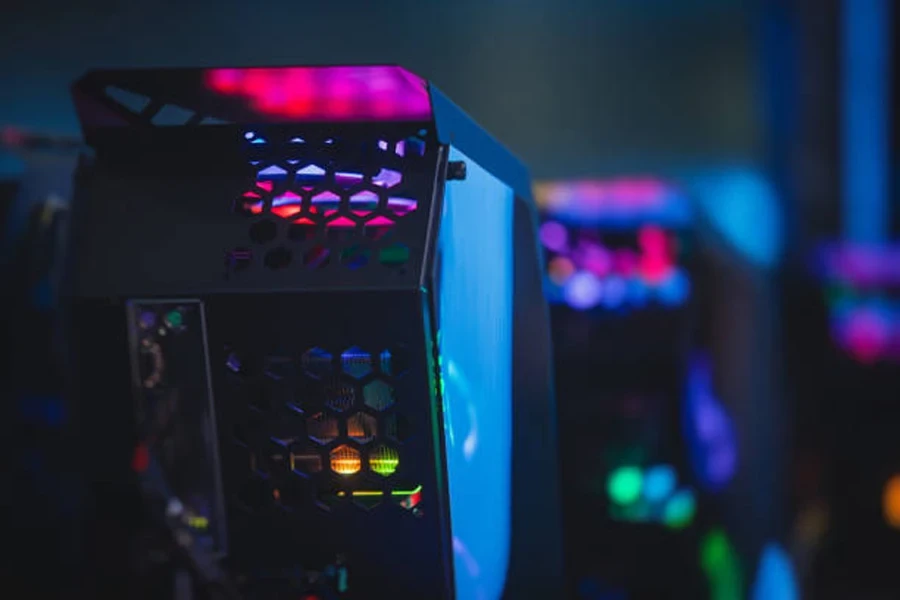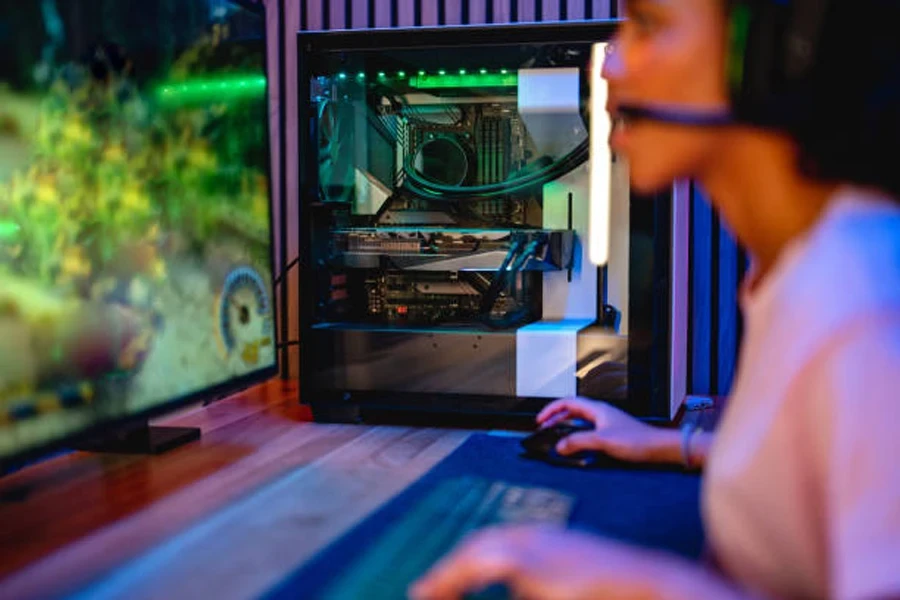Selecting the right graphics card for PC gaming in 2024 is crucial for achieving optimal performance and an immersive gaming experience. Graphics cards, or GPUs, are the heart of any gaming setup, responsible for rendering images, videos, and animations smoothly and with high quality. The latest models offer advancements like ray tracing, AI-enhanced graphics, and increased VRAM, which significantly enhance visual fidelity and gameplay. For professionals in the industry, choosing the right GPU means ensuring that the products meet the high demands of modern games and provide gamers with superior performance, whether for casual play or competitive gaming.
Table of Contents
1. Types and Uses of Graphics Cards
2. Current Market Trends
3. Key Factors in Selecting a Graphics Card
4. Top Graphics Cards of 2024
5. Conclusion

Types and Uses of Graphics Cards
Entry-Level Graphics Cards
Entry-level graphics cards are designed to offer sufficient performance for budget gaming setups. These GPUs are ideal for casual gamers who play less demanding titles or those new to PC gaming. They provide a good balance between cost and performance, ensuring smooth gameplay at 1080p resolution. Models like the Nvidia GeForce RTX 4060 and AMD Radeon RX 7600 are popular choices in this category. These cards offer features such as basic ray tracing and efficient power consumption, making them suitable for entry-level gaming rigs. They are also compact, fitting into smaller cases and requiring less power, which is beneficial for cost-conscious builds.

Mid-Range Graphics Cards
Mid-range graphics cards cater to mainstream gamers looking for a balance between performance and price. These GPUs are capable of handling more demanding games at higher settings, typically supporting 1440p resolution with good frame rates. Examples include the Nvidia GeForce RTX 4070 Ti and AMD Radeon RX 7800 XT. These cards often feature enhanced ray tracing capabilities, larger VRAM capacities, and higher clock speeds compared to entry-level models. They strike a perfect balance for gamers who want to experience modern games with high visual fidelity without the premium price tag of high-end GPUs. Additionally, mid-range cards offer better longevity, ensuring they remain relevant for a longer period.
High-End Graphics Cards
High-end graphics cards are designed for enthusiasts and professional gamers who demand the highest performance and quality. These GPUs are built to handle the most demanding games at ultra settings and support 4K resolution with high frame rates. The Nvidia GeForce RTX 4090 and AMD Radeon RX 7900 XTX are prime examples of high-end graphics cards. They boast advanced features like superior ray tracing, large amounts of VRAM (up to 24GB), and cutting-edge cooling solutions. High-end GPUs are also equipped with the latest technologies such as DLSS and FSR, which enhance performance and visual quality through AI-driven upscaling techniques. These cards are ideal for competitive gaming, streaming, and content creation.
Specialized Graphics Cards
Specialized graphics cards are tailored for specific needs such as virtual reality (VR) gaming, content creation, or professional workloads. These GPUs often have unique features and optimizations that set them apart. For instance, the Nvidia GeForce RTX 4090 excels in ray tracing, making it perfect for games that require detailed lighting and reflections. Similarly, GPUs designed for VR, like the AMD Radeon Pro series, offer high frame rates and low latency to ensure a smooth and immersive experience. These cards might also include additional outputs for multiple display setups and enhanced driver support for professional applications. For users with specific requirements, specialized graphics cards provide the performance and features needed to meet those demands.

Current Market Trends
Market Growth and Demand
The graphics card market has witnessed robust growth in recent years, driven by increasing demand from both gamers and professionals. According to market research, the global GPU market is projected to reach a value of $104.9 billion by 2025, with a compound annual growth rate (CAGR) of 33.6%. This surge is attributed to the rising popularity of high-resolution gaming, virtual reality (VR), and artificial intelligence (AI) applications. The expansion of the e-sports industry has also significantly contributed to this demand, as competitive gaming requires high-performance GPUs to deliver smooth and immersive experiences. Additionally, the growing interest in cryptocurrency mining has further fueled the demand for powerful graphics cards.

Technological Advancements
Technological advancements in GPU technology have played a pivotal role in enhancing performance and expanding capabilities. The introduction of ray tracing technology has revolutionized the visual quality of games by simulating realistic lighting and shadows. Nvidia’s DLSS (Deep Learning Super Sampling) and AMD’s FSR (FidelityFX Super Resolution) are key innovations that use AI to upscale lower-resolution images, resulting in better performance and image quality. Furthermore, the development of GPUs with increased VRAM capacities and faster memory bandwidth has enabled smoother gameplay at higher resolutions. These advancements are not only improving gaming experiences but also supporting complex computational tasks in professional fields like AI research, data analysis, and 3D rendering.
Consumer Preferences
Consumer preferences in the graphics card market have evolved significantly, with a growing emphasis on performance, value, and additional features. Gamers are increasingly opting for GPUs that offer a balance between price and performance, favoring mid-range models that can handle high settings at 1440p or 4K resolutions. There is also a strong preference for graphics cards that support advanced features like ray tracing and AI-enhanced graphics. Additionally, the market has seen a shift towards energy-efficient models, as consumers become more conscious of power consumption and its impact on both operating costs and environmental sustainability. Customization options and aftermarket support are also important factors, as many consumers look to optimize their systems for specific use cases or aesthetic preferences.

Key Factors in Selecting a Graphics Card
Performance and Resolution
When selecting a graphics card, performance benchmarks and resolution capabilities are crucial factors to consider. Performance benchmarks provide a quantifiable measure of a GPU’s capability to handle various tasks, particularly gaming at different settings. High frame rates and smooth gameplay are essential for an immersive experience, especially at higher resolutions like 1440p and 4K. GPUs such as the Nvidia GeForce RTX 4090 and AMD Radeon RX 7900 XTX are designed to deliver exceptional performance at these resolutions, ensuring that games run smoothly with high visual fidelity. It’s important to match the GPU’s performance with the intended resolution to avoid bottlenecks and maximize the gaming experience.

VRAM and Memory Bandwidth
VRAM (Video Random Access Memory) and memory bandwidth are significant considerations for a graphics card. VRAM stores image data that the GPU accesses quickly, which is crucial for rendering high-resolution textures and complex scenes. Modern games and applications require substantial VRAM, with 8GB being the minimum for 1080p gaming, while 12GB or more is recommended for 1440p and 4K gaming. Memory bandwidth, on the other hand, affects the speed at which data is transferred to and from the VRAM. Higher bandwidth ensures that the GPU can handle large amounts of data more efficiently, resulting in better performance. Graphics cards like the Nvidia GeForce RTX 4080 Super, with its 16GB of GDDR6X VRAM and high memory bandwidth, exemplify the importance of these specifications.
Compatibility and Power Requirements
Ensuring compatibility with existing systems and meeting power requirements are essential when selecting a graphics card. Compatibility involves checking that the GPU fits within the PC case, is supported by the motherboard, and can be properly cooled. High-end GPUs, such as the Nvidia GeForce RTX 4090, often require more space and advanced cooling solutions. Power requirements are another critical factor, as powerful GPUs consume significant amounts of electricity. It’s important to have a power supply unit (PSU) that can deliver adequate power to the GPU without causing instability. A 750W PSU is generally recommended for high-end graphics cards to ensure reliable performance and avoid power-related issues.
Additional Features
Additional features like ray tracing, DLSS (Deep Learning Super Sampling), and FSR (FidelityFX Super Resolution) significantly impact the gaming experience. Ray tracing enhances visual realism by simulating light behavior, creating more lifelike reflections, shadows, and lighting effects. DLSS and FSR are AI-driven upscaling technologies that improve performance by rendering games at a lower resolution and then upscaling the image to a higher resolution. These features allow for higher frame rates and better visual quality without the same performance cost as native high-resolution rendering. GPUs such as the Nvidia GeForce RTX 4070 Super and AMD Radeon RX 7800 XT include these technologies, offering a balance of performance and advanced features that enhance the overall gaming experience.

Top Graphics Cards of 2024
Best Budget-Friendly Options
For those seeking cost-effective yet powerful graphics cards, several models stand out in 2024. The Nvidia GeForce RTX 4060 is a prime example, offering excellent 1080p performance at a relatively low cost. This card features 8GB of GDDR6 VRAM and supports Nvidia’s DLSS technology, providing smooth gameplay and efficient power consumption. Similarly, AMD’s Radeon RX 7600 is a strong contender in the budget category, delivering solid 1080p performance with 8GB of GDDR6 VRAM and additional support for AV1 encoding. Both options provide great value for gamers looking to upgrade their systems without breaking the bank.

Top Mid-Range Picks
Mid-range graphics cards offer a balance between performance and price, catering to gamers who want to play modern titles at higher settings. The Nvidia GeForce RTX 4070 Ti is a standout choice, featuring 12GB of GDDR6X VRAM, excellent ray tracing capabilities, and support for DLSS 3. This card excels at 1440p gaming, providing high frame rates and detailed visuals. Another strong mid-range option is the AMD Radeon RX 7800 XT, which offers 16GB of GDDR6 VRAM and impressive performance in both rasterization and ray tracing. These mid-range cards are ideal for gamers who want to experience high-quality graphics without the premium price tag of high-end models.
Leading High-End Choices
For those seeking the best performance available, high-end graphics cards deliver unparalleled power and advanced features. The Nvidia GeForce RTX 4090 is currently the fastest GPU on the market, boasting 24GB of GDDR6X VRAM, exceptional ray tracing performance, and support for AI-driven DLSS 3. This card is perfect for 4K gaming and demanding professional applications. AMD’s Radeon RX 7900 XTX is another top-tier option, featuring 24GB of GDDR6 VRAM and excellent rasterization performance. While it lags slightly behind Nvidia in ray tracing, it offers a compelling price-performance ratio for high-end gaming.

Conclusion
Selecting the right graphics card for PC gaming in 2024 involves understanding various factors, including performance, VRAM, compatibility, and advanced features like ray tracing and DLSS. With the market offering a range of options from budget-friendly to high-end models, professionals must consider specific needs and budget constraints. The Nvidia GeForce RTX 4060 and AMD Radeon RX 7600 provide excellent value for budget-conscious buyers, while the RTX 4070 Ti and RX 7800 XT cater to mid-range requirements. For those seeking top-tier performance, the RTX 4090 and RX 7900 XTX stand out. Making an informed choice ensures optimal gaming experiences and meets the demands of modern applications.




